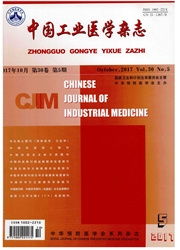

 中文摘要:
中文摘要:
目的从分子层面探讨油酸性急性肺损伤的启动机制。方法分别在大鼠尾静脉注射油酸,于0.5、1、2、6、24h后,观察氧自由基产生及与其清除相关的氧化-抗氧化指标,同时检测肺组织中活性氧(reactive oxygen species,ROS)、肺湿/干重、血气分析及病理学的动态变化,并用抗自由基的吡菲尼酮(20、40、80mg/kg灌胃)作用后检测上述指标动态变化。结果大鼠尾静脉注射油酸后XO活性和NADPH氧化酶组分(p47phox蛋白)表达高峰在1h和6h,与肺组织ROS含量的两个时间高峰相一致;肺组织GSH-Px活性和总抗氧化能力在注射油酸后2h-过性升高随后降低,而肺湿/干重比和病理学评分在油酸注射后1h达到峰值,动脉血氧分压在油酸注射后2h逐渐降至最低。吡菲尼酮作用后,随着自由基减少,急性肺损伤各项指标均有所好转。结论通过正反两方面证实,XO和NADPH氧化酶过量及导致ROS的大量生成乃ARDS最重要的源头事件,其对血管内膜的损伤,可进而引起微血管血栓形成、毛细血管膜-肺泡通透性增加及肺水肿形成,从而严重影响肺的通气换气功能,降低血氧分压,导致严重低氧血症,构成了急性肺损伤的病理学基础。
 英文摘要:
英文摘要:
Objective The aim of our study is the major cellular pathways of ROS production in oleic acid induced acute lung injury. Method Oleic acid induced group administered oleic acid (0.15 ml/kg, iv). The animal model of ARDS was verified by blood gas analysis and pathological examination of lung. To examine the major cellular pathways of ROS production in the lung, we assayed myeloperoxidase (MPO) activity, xanthine oxidase (XO) activity, the important component of nicotinamide adenine dinucleotide phosphate oxidase (NADPH oxidase) -p47phox expression, glutathione peroxidase (GSH-Px) activity, total antioxidation capability (TAC), and reactive oxygen species (ROS) measured directly by electron spin resonance (ESR) spectroscopy in lung tissue at different time paints without or with piffenidone (20 mg/kg, 40 mg/kg and 80 mg/kg, p.o, respectively). In addition, we explore lung wet/dry ratio, arterial blood gas analysis and lung pathologic score. Result ESR showed the content of ROS in the lung began to rise at 30 min and was measured at 1 h and 6 h after OA injection. The trend of the peak of the activity of XO and the component of NADPH oxidase, protein 47phox was unanimous with the Change of lung ROS content by ESR, which showed NADPH oxidase and XO contribute to generating free radicals in lung with OA induced ARDS. The activity of GSH-Px and the total antioxidant capability increased only at 2 hours after OA injection in the lung, which shows that the increase of antioxidation did not overwhelm the excessive ROS generation from oxidant enzymes, and then the capability of the antioxidation system declined by excessive ROS generation from the oxidant enzymes, lung wet/dry ratio enhanced significantly at 1 hour after oleic acid injection. Arterial blood gas analysis showed that arterial partial oxygen pressure was down to the lowest at 2 hours after OA injection. The sequence of the effect of PFD in ALl rats was at 0.5 h (MPO and p47phox), 2 h (GSH-Px and TAC) and 6 h (XO?
 同期刊论文项目
同期刊论文项目
 同项目期刊论文
同项目期刊论文
 期刊信息
期刊信息
